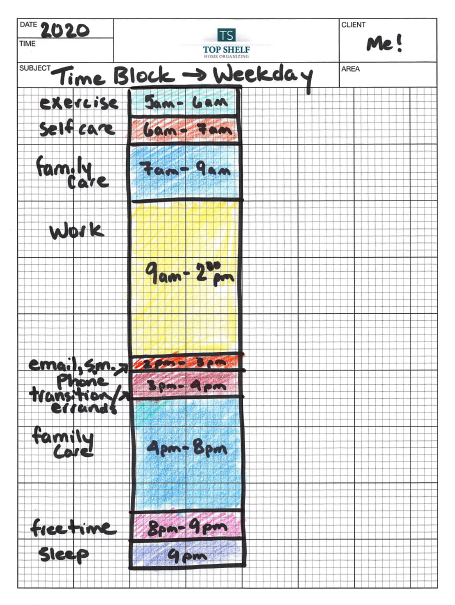by Jayme | Jul 21, 2021 | Clutter, Organizing, Saving Time
 For many of us, getting organized is manageable but maintaining the organization is a challenge. Whether you spend your weekend binge organizing or outsource your organizing projects to a professional, the organization systems need to be maintained. As a busy mom of four, dog mom of two pooches, wife, and business owner, I want to share my 10 favorite personal tidy tips that help me keep sane when the day is hectic.
For many of us, getting organized is manageable but maintaining the organization is a challenge. Whether you spend your weekend binge organizing or outsource your organizing projects to a professional, the organization systems need to be maintained. As a busy mom of four, dog mom of two pooches, wife, and business owner, I want to share my 10 favorite personal tidy tips that help me keep sane when the day is hectic.
- Make Your Bed
Make your bed right when you crawl out.
- Put Your Stuff Away, Right Away
Remember how it takes time and resources to get organized? Now you need to put your things away to keep your home organized.
- Make the Rounds
Make the rounds through your house to collect and put away miscellaneous items daily or twice daily.
- Run the Dishwasher
Empty the dishwasher first thing in the morning. This will start your day with a clean slate in the kitchen. Load the dishwasher throughout the day with soiled dishes. Run the dishwasher nightly. Repeat this process every day to prevent a dirty dish pile-up.
- Clean-Up as You Go
Wipe the countertops after each meal. Wipe the bathroom counter and faucet after you brush your teeth. Squidgy the shower walls and door after a shower. Wipe spills and splatters as they happen.
- Have a Schedule
Have a day scheduled for larger tasks, even if you cannot dedicate a full day to these tasks. Focusing time on just one task will get it done more efficiently than juggling all the tasks unsuccessfully at one time.
-
- Grocery day
- Meal prep day
- Laundry day
- Cleaning day
- Additionally, use a deep clean schedule to help rotate through deep cleaning areas of your home. Schedule one area per week.
- Think Tidy When You Walk Through the Door
-
- Leave your shoes at the door
- Put your bag on its hook
- Keys go where they belong
- Leave Nothing on the Floor
-
- Keep toys, papers, blankets, and dirty clothes off the floor
- Hang up clothes you will re-wear right away
- Place dirty clothes go into the hamper
- Towels get hung on the hook
- Toys get put away when not being used
- Take Out the Trash
Take out the trash when you leave the house for the day. This will keep odors out of your house while you are gone. It will also feel good to see an empty garbage can when you get home from a busy day. Don’t forget garbage collection day. All trash and recycling need to go out on trash day.
- Deal with Mail Daily
Collect, sort, purge, and file mail daily. Removing the junk mail daily will make your mail opening day more manageable. File important mail in one location so it is gathered together and ready when you need to open it. Open the mail when you are ready to address, pay, and file it.
Establishing and maintaining a routine will help your home stay tidy. At Top Shelf Home Organizing, we love to help busy households get organized. If you are looking for guidance on getting your home or office organized, reach out to Jayme.
by Jayme Radomski | Oct 22, 2020 | Busyness, Clutter, Managing Time, Organizing, Productivity, Saving Time
 I was recently asked by an organization I belong to, to share my inspiration to start a business. I then realized what a better audience than all of you to share that inspiration with, as well.
I was recently asked by an organization I belong to, to share my inspiration to start a business. I then realized what a better audience than all of you to share that inspiration with, as well.
Top Shelf Home Organizing started in 2014 after having a discussion with friends about what our dream job would be if we could do anything. After watching all their jaws drop when I said I would organize people’s closets and basements, I knew there was a need. Since then, my business has been effectively helping people organize their homes and offices, simplify their routines, and clear their schedules. I am personally involved in all projects and have six wonderful ladies that help on various projects.
We help busy families with projects that range from pantry organizing projects to full-home, plus storage units. Some individuals just need the accountability to get through an organizing project, and others need full-service help where we handle the complete organizing project.
I have always had a bit of an entrepreneurial mind. Going back to babysitting jobs, waiting tables, and working as a consulting engineer, I always tracked the time I spent on a project, the revenue each project brought in, how my job could be done more efficiently, and what types of projects brought the most value. I treated projects like my own little business.
After 15 years of professional experience working in various leadership roles, I knew it was time to do something I was passionate about. My youngest of four kids was about six months old, and I was in the thick of balancing parenting and a career. So I knew my skill set would be valuable to other busy professionals.
My favorite part of Top Shelf Home Organizing is the clients. It can be a very personal thing helping them to organize their home, basement, or closet. I often hear stories from their childhood, past careers, current life struggles, and their aspirations. It is not uncommon to get a message from a client on a Sunday afternoon asking how my kids are, how big our puppy is, or asking for a recommendation on a carpenter, decorator, or just a simple hello. Clients become friends.
If you want to learn more about Top Shelf Home Organizing or just want to chat about an organizing project you have going, you can find me at:
Phone: 262-373-9416
Email: jayme@topshelfhomeorganziing.com
Web: topshelfhomeorganizing.com
Facebook: https://www.facebook.com/topshelfhomeorganizing
Pinterest: https://www.pinterest.com/TopShelfHomeOrg/
Instagram: www.instagram.com/jaymeradomski
by Jayme Radomski | Feb 12, 2020 | Busyness, Managing Time, Productivity, Saving Time

You should protect your time with time blocking, regardless of your responsibilities. Whether you are a busy professional well into your career, a full-time caregiver to your family, or just juggling many responsibilities, blocking your time will set boundaries around your professional and personal time and allow you to maximize your productivity.
Blocking your time is a written reminder of where you need be, literally and mentally, at any time of the day. Time blocking allows you to focus deeply on the task that needs to be completed. For example, when you have time blocked for self care in your schedule, all you need to focus on in the self care time block is caring for yourself. Just like budgeting your money, time blocking makes you aware of how you spend your time (and where you waste your time). Time blocking is a written commitment to what you spend your time on.
To start time blocking, make a list of your daily tasks, this is a high level list. Each task may have multiple sub-tasks within it. We will address these later. This is just a list of what you should do everyday. As an example, here is a list of Jayme’s daily tasks. Included in the list are a couple items I would like to make time for (reading, a hobby and free time).
- Sleep
- Self care
- Family care
- Reading
- Exercising
- Work
- Email, Social Media
- Planning for tomorrow
- Free time
- Hobby
Combine smaller tasks into a task batch. Task batching is grouping smaller tasks into one chunk of time. This could include checking and responding to email, returning phone calls and checking social media. Another batch may include a few items that are complete during some personal time (reading, hobby and free time). A morning routine could also be batched, as these events naturally occur together and fit into a schedule by design (self care, family care and exercise). In this example, family care is also a batch. Family care may include cooking, mealtime, bathing, homework help, and carpooling.
Your work time is naturally where you would task batch items you need to complete to make money. Notice I wrote, “make money.” This is where you mark your time as busy to focus on the items that eventually pay your bills. You tell your assistant or whoever you work with that your door is closed, and non-critical family chats and conversations can wait. This is the time you focus on your work. There are other times of your day where you may mark yourself busy, as well. These times may be when you are physically not available such as sleep and exercise.
Day theming works well if you have large portions in each day that you need to dedicate to different areas to meet the same goal. For example, if you work from 9am to 3pm each day, you may want to dedicate one day for client meetings and client follow up, another day for writing, another day for administrative tasks, and two other days for marketing. If you have projects, there are days of the week you may need to dedicate to the one or many projects you have going on.
Time blocking takes planning and revisions. Your initial plan for a time block may need to be revised frequently in the beginning. Give yourself some grace. If you are not seasoned to planning your day, keep it very simple in the beginning and allow flexibility. Life if going to happen and your schedule may go astray. You will find peace though knowing that there is a daily plan, and if you stick to the plan productivity will happen. As your productivity increases and evolves, you will find more free time in your day and your week.
Time blocking can be done with a simple paper calendar or planner, or with an online calendar or application. I would recommend starting with a simple paper and pencil to plan your time. After getting used to the idea of scheduling your time into blocks, try a digital calendar or app where you can experiment with colors and tags.
If planning your time causes you stress and anxiety, Top Shelf Home Organizing would love to help you on your journey. Jayme can help you plan your time blocking, set your goals, and keep you accountable to meeting those goals.
by Jayme Radomski | Jan 8, 2020 | Clutter, Organizing, Saving Time

Setting Realistic Organizing Goals
In this new year and new decade, I want to share with you some simple ideas on how to set goals to be more organized in 2020. Being organized is a journey. To expect to become completely organized this month if you have not been organized in the past year or decade is unrealistic. Setting small weekly goals to get your home organized will be more manageable, leave you time to continue with your daily activities, and allow you to celebrate many small victories.
5 W’s of Goal Setting
Take some time to think about the benefits of being organized, and what that will look and feel like for you. Start a journal or notebook to track your progress, motivations, slowdowns and feelings. A good guideline for setting goals is to look at the five W’s.
- Why is it important for you to become and stay organized? How will this help you to be the best you?
- Where do you think you need the most organization? Is it an area of your home? Is it an area of your office? Would having more structure to your schedule be beneficial?
- When will you accomplish your goals? When will you make time to work on your goals? Set a realistic time frame to meet your goals. Getting organized is a journey, not a one-stop trip. Plan time in your days and your weeks to accomplish small goals.
- Who will be affected by being organized? Obviously you will directly benefit. Think about the other people who will positively benefit from organization and structure. Your boss will feel the benefits of your workspace being organized and your schedule more structured. Family members will see the benefits of an organized home and feel the benefits of you being less stressed. Relationships will flourish when this area of your life is under control.
- What do you want to organize? Look at the big picture and break it down into small steps and then into even smaller steps. If you want your entire home, office, storage unit, garage, attic and vacation home organized, you will need to set goals in each area. Furthermore, goals will need to be set for each room, and then even smaller goals will need to be set for each file, drawer, closet, box and bin. For example, if your goal is an organized bedroom, you will want to break your bedroom down into smaller categories. These smaller categories could include closet, dresser, under bed storage, bathroom and linen closet. Each of these areas can be broken down into very small projects that take just minutes. Your dresser can be separated into smaller categories such as undergarments, socks, pajamas, swimwear, t-shirts and accessories. A similar method can be applied to other areas.
Goal Setting Basics
- Specific
Be specific about your goals. Goals should be specific to what you really want and need to be organized. Go further than general statements like “I am going to get organized” and “I am going to organized my whole house.” Specific goals will go deep and detail areas of your home, and further into rooms, and then into drawers, closets, categories, boxes and bins.A calendar is a great way to break down your project into small specific goals. Each month you will have a large goal. The large goal can be broken down into smaller weekly goals, and then even further into very manageable daily goals. The smaller goals should be focused on achieving a larger goal to ensure a part of the project gets completed. If you are working on basement organizing, the smaller goals should lead you to accomplishing that larger goal.
- Measurable
You will want to have a way to measure your progress. Progress with getting organized can be a photo to visually remind you of what you have accomplished. It will help to know where you started and how far you have come. A simple check list or spreadsheet can also help you mark off your progress.
- Attainable
Set goals that you can achieve. Success meeting your goals will motivate you to keep going. Setting goals that will only take minutes a day will be more attainable than goals that take many hours out of your week. An attainable goal for you may be cleaning and organizing a refrigerator shelf, not the entire refrigerator. It will always feel better to move on to the next small goal when you have time than to set goals so large you cannot complete even one.
- Realistic
Be realistic about your time, lifestyle and goals. If your weekends are packed with running to activities and enjoying time with family and friends, you may only have a few minutes to work on your goals. Don’t plan to organize your entire office on Saturday if you have a full schedule. That will only lead to failure and frustration.
- Timely
Set timely organizing goals. Making progress will keep you motivated. If you plan for an organizing project to go on too long, you may lose focus. Planning your goals to be accomplished in a timely manner will help you and others see and learn that progress has happened and keep you going.
There are many monthly and daily organizing calendars available online. These can provide a great guide for you to plan your organizing journey. Top Shelf Home Organizing would love to help you on your journey. Jayme would be happy to help you set your organizing goals, and help you achieve your organizing goals.
by Jayme Radomski | May 3, 2019 | Clutter, Productivity, Saving Time, Wardrobe
Preparing for a season transition can be stressful, especially if you have school aged children wrapping up their school year and end of year performances. While May is a busy month, I have created a list of things to do before summer is in full swing. The key to summer is to have a plan. 
- Budget
Summer days feel carefree and wide open. Your budget, however, may not be. Take some time to think about your summer budget. Summer time brings extra childcare and camp expenses. You may also be working a reduced schedule. Sticking to a budget can make your summer less stressful and more accomplished. No one wants to end the summer in debt and stressed out.
- Schedule
A change in schedule for the family will bring new challenges. Plan ahead for summer activities and childcare. For you, schedule time for self care and exercise. If you are good about getting to the gym during the school year, you will want to schedule similar exercise time in the summer. It’s easy to put other family member’s schedules before yours in the summer. Your local library and school are great resources for scheduling activities for your children.
- Travel
Its time to plan your travel routes and lodging for summer travel. Choose your destination, and schedule and research the best flights, routes and lodging. If you have your travel plans nailed down, its time to get into the details. Research the best local cuisine, fun day excursions, the best parks in the area, and free things to do with kids. It is also a good idea to gather all important travel documents, and know where the local medical clinics are and drug stores for necessities while traveling. For the weekends you are local, research your city’s summer bucket list for fun local explorations.
- Lazy Days
Plan plenty of lazy days for you and your family. Allow yourself some time to read a book, nap in the hammock or putts in the garden. Kids love exploring in the backyard, creating fairy gardens, collecting bugs and camping in the backyard. These creative activities are tough to accomplish with an overscheduled summer.
- Self Care
Do a few things for yourself in advance of summer time. Schedule a hair appointment for a fresh cut and color. Pay attention to your feet by starting the sandal season with a fresh pedicure. Stock up on sunscreen for both your body and your face. Declutter your makeup, toss the old items and add a fresh lip color to your collection. This is also a great time to clean out your medicine cabinet. Dispose of expired or unneeded medications, and ensure your first aid kit is stocked.
- Your Wardrobe
If you have not yet transitioned your wardrobe, do it now. Purge the fall, winter and spring items that don’t suit you, instead of packing them away. If you didn’t like them this year, you won’t like them next year (even if you lose the ten pounds you are working on). For your summer wardrobe, get all items from storage. Carefully select the items you want to wear, purge the rest. Make a list of items you need to complete your wardrobe and carefully purchase only those items.
- Kids Wardrobe
This purge is very similar to what you would do for your own wardrobe. The good news is that it is easier to work through someone else’s clothes than your own. Remove the fall, winter and spring items that are worn, stained and will not fit your children next year. If you are saving clothing for a younger child, only save the items that you truly love and are in good condition. There is no reason to handle stained or worn clothes more than one time. Neatly pack away the clothes you are saving. Make sure they are clean and neatly folded, and placed in clear plastic bins that are labeled so you know right where to find them. Make a list of the items your children need for the summer season, so you can once again shop with meaning. Keep in mind summer camp and extended trips when inventorying kids clothes.
- Purge Toys
With the kids spending more time outdoors, it is a great time to get into the playroom and basement, and purge the toys they don’t receive joy from. Consider the plastic toy sets they received for their birthday that are now missing parts and have broken pieces, the toys they scatter around unproductively, the nostalgic toy your mother-in-law picked up at a rummage sale last summer, and the toys they have simply outgrown. Keep the basic toys that allow for creative play such as Legos, Magna tiles, dolls and a few Nerf guns.
- House
Prepare your house for a fresh start to the summer. Taking care of a few things inside and out gives you a neat and clean feel for the summer. Inside the house a good deep clean and purge will free up some space. Clean the windows for a clear view, and clean the oven now that roasting season is over. Have your air conditioning system inspected and serviced. Moving to the outside, give your grill a good scrub down. You’ll be amazed how great a clean grill can feel. Wash down patio furniture and the cushions for meals on the porch. Tackle the weeds in the garden now while the soil is moist and soft, and weeds are small. Apply a pre-emergent to your gardens as well to prevent new weeds from appearing. Seed the areas of your lawn that are thin. Add some fresh annual flowers to the front flower beds for some curb appeal. Clean the walkway, driveway and garage floor. Prepare your lawn mower by servicing the engine and sharpening the blades. Inflate the bicycle tires and grease the chains for summer bike rides.
At Top Shelf Home Organizing, we love to help people get stuff done. See if Top Shelf Home Organizing can help you get ready for summer. Contact Jayme to schedule a consult or chat about organizing.
 For many of us, getting organized is manageable but maintaining the organization is a challenge. Whether you spend your weekend binge organizing or outsource your organizing projects to a professional, the organization systems need to be maintained. As a busy mom of four, dog mom of two pooches, wife, and business owner, I want to share my 10 favorite personal tidy tips that help me keep sane when the day is hectic.
For many of us, getting organized is manageable but maintaining the organization is a challenge. Whether you spend your weekend binge organizing or outsource your organizing projects to a professional, the organization systems need to be maintained. As a busy mom of four, dog mom of two pooches, wife, and business owner, I want to share my 10 favorite personal tidy tips that help me keep sane when the day is hectic.



